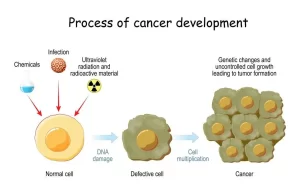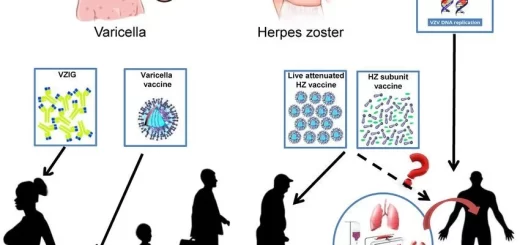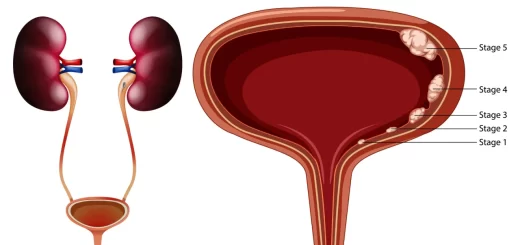Cancer genetics, Genetic defects in tumours, Oncogene activation and Examples of hereditary cancer
Gene changes that start in a single cell throughout a person’s life cause most cancers, Genetic changes that cause cancer can be inherited or arise from certain environmental exposures, Genetic changes can happen because of errors that occur as cells divide, cancer is a genetic disease, It is caused by changes in genes that control the way cells grow and multiply.
Cancer genetics
The genetics hypothesis of Cancer development (a multistep process of carcinogenesis):
- Cancer is a genetic disease of somatic cells.
- Results from a primary genetic defect and this mutation is not repaired: this is the first step in tumour development in which the mutation transforms the cell into tumour progenitor: Stage of Initiation.
- The initiated cell is promoted by exposure to some agents such as hormones to stimulate uncontrolled proliferation (Stage of promotion & clonal expansion).
- Multistep of carcinogenesis and tumour progression: during uncontrolled proliferation, there is an accumulation of extra secondary genetic changes which results in tumour progression.
Genes involved in tumourigenesis
1. Oncogenes: are the mutant forms of a normal cellular gene, proto-oncogenes. These are genes normally involved in cell growth and proliferation. Increased or abnormal function of proto-oncogenes transforms them into oncogenes. Activation of these genes occurs in a dominant way, i.e. mutation of a single allele is enough to transform a cell and initiates tumourigenesis.
Types of oncogenes: They may be growth factors, growth factors receptors, tyrosine kinase signal proteins or transcription factors.
Mechanism of oncogene activation
- Point mutation resulting in an abnormal function of a protein such as sustained activation (e.g. RAS oncogene).
- Translocation and creation of a new protein with a growth-promoting function (e.g. t(9:22) produces BCR-ABL protein with protein kinase activity acts as signal transmitter in myeloid leukemia).
- Over-expression of a proto-oncogene, through the following mechanisms:
- Translocation: results in bringing a proto-oncogene next to an active promoter and hence over expression of the proto-oncogene occurs, e.g. t(8:14) in Burkitt’s lymphoma which activates c-MYC oncogene and t(14,18) in follicular lymphoma which results in overexpression of BCL2 (antiapoptosis protein).
- Gene amplification results in an increased number of gene copies. (e.g. c-erb or Her2-neu in Breast cancer or EGFR in bladder cancer).
2. Tumour suppressor genes (TSGS) “Gate Keepers of the genome“: normally function as cell cycle regulators or cell proliferation inhibitors: e.g. Tp53, NF1 (neurofibromin), RB retinoblastoma gene, Loss of function of a “gate keeper gene” occurs in a recessive way, i.e. both alleles have to be mutated and lose their function as growth regulators.
Two hit theory of cancer applies to the inactivation of 2 alleles of a tumour suppressor gene. An example is in retinoblastoma where the tumour does not develop until 2 mutations happen in the RB gene.
3. DNA repair genes “Caretakers of the genome“: These genes maintain the integrity of the DNA during replication and correct DNA damage that occurs as a result of exposure to environmental factors. Loss of function occurs in a recessive way, i.e. by mutation of both alleles.
- Mismatch repair genes (mutation of any of member of these genes result in accumulation of mutations in TSGs and oncogenes).
- Genes involved in DNA strand breaks.
4. Apoptosis-related genes: involves genes that regulate apoptosis and result in the survival of abnormal cells with DNA defects (transformed cells) and tumour progression. (For example over expression of BCL2 (antiapoptotic) occurs as a primary defect in follicular lymphoma).
Genetic defects in tumours
- Primary defect: this is a non-random defect and is present in all the cells of the tumour and is considered as the “initiation” event. This defect can be inherited in hereditary cancer syndromes or acquired as a result of exposure to environmental factors.
- Secondary defects: These accumulate during tumour cell division and result in the tumour acquiring more aggressive behaviour such as invasion and metastasis.
Types of Genetics abnormalities in tumours
- Chromosomal abnormalities: in the form of aneuploidies and structural abnormalities.
- Genomic changes:
- deletion (usually involves TSGs),
- amplification (usually involves oncogenes).
- genomic instability (resulting from DNA repair gene defect).
Hereditary/ Familial Cancer
These are cancers that run in families due to the inheritance of a genetic defect i.e. inheritance of a germline mutation in an oncogene or tumour suppressor gene “gatekeeper gene” or DNA repair gene “caretaker gene”. Not all familial cancers are hereditary because some types of cancer may run in families because of similar exposure to carcinogenic environmental factors.
Examples of hereditary cancer
1. Retinoblastoma: is a malignant tumour of the retina. It occurs as familial or sporadic cancer. The familial type occurs at an earlier age of childhood and may be bilateral, due to an inherited germline mutation in the retinoblastoma gene (gate keeper TSG). It is inherited as autosomal dominant and shows reduced penetrance. This is because of the need for the two hits required to knock off both alleles of the RB gene to initiate a retinal cell to form a tumour.
2. Neurofibromatosis type 1: inherited as autosomal dominant due to mutation in NF1 which is involved in neuron cell growth regulation, by acting as a tumour suppressor gene. It is associated with an increased risk of brain tumours and benign and malignant neurofibromas. It is inherited as autosomal dominant and shows variable expression.
3. Familial Breast cancer, represents 5% of the total breast cancer. Due to inherited mutation in the caretakers TSGS: BRCA1 or BRCA2. It is characterized by an earlier age of occurrence of breast cancer, bilaterality and several members of the family are affected with breast cancer or other types of cancer. It may also cause male breast cancer in families having hereditary breast cancer. It is inherited as autosomal dominant and may also show reduced penetrance.
4. Hereditary Colon cancer:
- Familial Adenomatous Polyposis, due to loss of function of the APC gene (TSG) and is characterized by hundreds – thousands (>100 polyps) of polyps in the colon which are considered to be 100% precancerous.
- Hereditary non-polyposis colon cancer: which are due to loss of mismatch repair genes (caretakers of the genome) which result in a state of genomic instability and increased risk of colon cancer and maybe also other cancer types as brain tumour in children, endometrial and urinary carcinoma
5. Xeroderma Pigmentosa: which results from loss of function of the DNA repair gene involved in the repair of double-strand breaks commonly caused by exposure to ultraviolet rays. It is characterized by repeated chromosome breakage and shows an increased risk to skin cancer. It is inherited as autosomal recessive.
Applications of Genetics in Cancer Management
- Diagnosis: detection of primary/non random genetic defect e.g. Philadelphia chromosome by FISH in the diagnosis of myeloid leukemia.
- Presymptomatic diagnosis of hereditary cancer and provision of genetic counseling and testing for BRCA1/2 genes mutations in familial breast cancer and hence screening program for early detection.
- Targeted therapy for example to inhibit an activated oncogene to decrease the rate of growth of the tumour e.g. antibodies to Her-2 neu in breast cancer which is over-expressing Her2.
You can subscribe to science online on YouTube from this link: Science Online
You can download Science Online application on Google Play from this link: Science Online Apps on Google Play
Cancer genetics, Genetic defects in tumours, Oncogene activation and Examples of hereditary cancer
Polygenic inheritance vs Single gene inheritance, Non-mendelian inheritance and Genomic imprinting
Chromosomal disorders, structure, classification, and Types of numerical chromosomal abnormalities
Genes, Chromosomes, Proteins, Bacteriophages & Quantity of DNA in the cells
Nucleus components, function, diagram & classification of chromosomes
Cells types, Chromosomes, Cell division, Phases of mitosis division & Liver Transplantation
Packaging of DNA, Genome, chromosomal proteins, DNA in Prokaryotes & Eukaryotes




